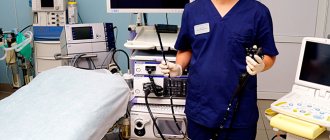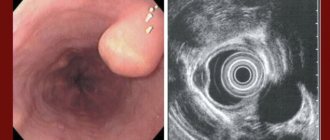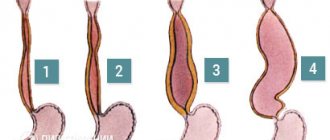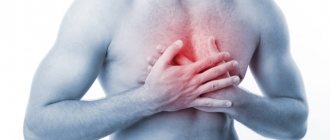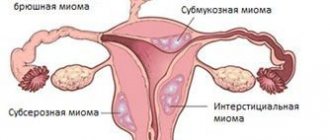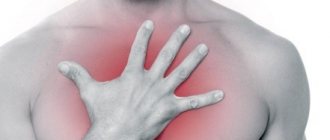Physiology of motility of smooth muscle organs
Most organs in which the process of peristaltic contractions occurs have two layers of smooth muscle in their walls, in one of them the muscle fibers are located longitudinally, in the other - circularly. The coordinated contractions of these muscles form a peristaltic wave. Smooth muscles, unlike striated muscles, contract relatively slowly. Their contractions are involuntary, that is, they cannot be controlled by consciousness.
For example, the muscles of the digestive tube organs are smooth, with the exception of the “input” (striated muscles are present up to the upper third of the esophagus) and the “output” (external sphincter of the anus). Therefore, after the start of swallowing and before the act of defecation, all processes associated with the movement of food, including peristalsis, are not controlled by consciousness.
The frequencies of peristaltic waves are different in different organs (departments). They are set by special pacemakers - clusters of nerve cells, among which the leading role is played by the interstitial cells of Cajal. Pacemakers generate slow waves of transmembrane potentials. Slow waves do not cause muscle contractions, but create a potential in the muscles close to the activation threshold. When slow waves of action potentials occur on a plateau, the muscle fiber contracts.
Pacemakers thus determine the frequencies of peristaltic waves (as well as other phasic contractions). In a healthy person they are as follows (in cycles per minute): in the stomach - 2-4, in the duodenum - 10-12, in the jejunum - 9-12, in the ileum - 6-8, in the colon - about 0, 6, as well as 3-4 and 6-12, in the rectum - about 3, in the sphincter of Oddi - 3-6.
In the small intestine, there are several types of waves that differ from each other. The speed of their passage can be smooth, slow, fast, and also rapid. As for the large intestine, the food bolus moves much more slowly, so the speed of the waves themselves decreases. Very strong contractions appear several times a day, which are what pushes food towards the anus.
Movements in the colon appear after the stomach cavity is filled.
If intestinal motility is disrupted, the absorption of vitamins and minerals is noticeably inhibited, food passes through the intestines with difficulty, and constipation develops. This condition requires urgent treatment, otherwise the situation will worsen. Against the background of slow peristalsis, food accumulates and becomes a source of toxins, bacteria, and parasites. If treatment is not started in time, the pathology provokes a number of diseases of the digestive tract.
The digestive system is one of the main mechanisms in human life. But at the same time, her organs begin to lose their functions first. An important point in the functioning of the gastrointestinal tract is intestinal motility. It can be strong or weak, but in any case, if violated, it causes a lot of unpleasant sensations.
Peristalsis is contraction of the intestinal muscles aimed at moving food masses throughout the organ.
Intestinal peristalsis is understood as wave-like contractions of the intestinal walls, which help push masses of feces towards the anus. This is one of several types of motor activity that occur in the intestines. It is thanks to the correct contractions that normal digestive processes are realized, during which all the necessary microelements are absorbed, and what is not absorbed leaves the body.
In order to maintain the normal functioning of the gastrointestinal tract for a long time, you need to monitor your diet, introduce physical activity and eliminate bad habits. In addition, it is necessary to promptly treat systemic diseases that affect the performance of the organ. If these conditions are not met, then peristalsis may be increased or, conversely, decreased, which is far from the norm.
Peristalsis begins to occur after the stomach has been filled with food. The norm is considered to be the case when 10-12 contractions occur per minute in the duodenum, 9-12 in the small intestine, 3 contractions in the large intestine, and no more than 3 in the rectum. If the patient experiences disturbances in peristaltic activity, they may constipation or diarrhea occur.
Peristalsis
Peristalsis
(from the Greek
peristaltikos
- grasping and compressing) is a wave-like contraction of the walls of the hollow tubular organs of the gastrointestinal tract or other systems (ureters, fallopian tubes, etc.), promoting the movement of their contents from the “entrance” of the organ to the “exit”.
Peristalsis of the esophagus
For the esophagus, peristalsis is the main type of motor activity. The speed of propagation of the peristaltic wave in the esophagus is approximately 3–5 cm per second.
There are primary and secondary peristalsis of the esophagus. Primary occurs immediately after the bolus passes the upper esophageal sphincter. Secondary is a reaction to bolus stretching of the esophageal wall.
The esophagus also contains so-called “cleansing” peristalsis, which is not associated with swallowing and is a reaction to irritation of the esophageal wall by food debris or refluxate that enters the esophagus from the stomach during gastroesophageal reflux.
Peristalsis of the stomach
Intestinal peristalsis
The motor activity of the intestine is very diverse and peristalsis is only one type of intestinal contraction.
During the period stimulated by food, several types of peristaltic waves propagate in the small intestine, which differ in the speed of passage through the intestine. There are very slow, slow, fast and rapid peristaltic contractions. Majority
peristaltic waves are formed in the duodenum, but there are also those that appear in the jejunum and ileum. At the same time, several peristaltic waves can move along the small intestine.
During the interdigestive period, migrating motor complexes, which also contain peristaltic waves, spread in the small intestine.
In the large intestine, the speed of movement of digested food is slower than in other parts of the intestine. Peristalsis in the colon takes a smaller percentage of time than in the rest of the intestine.
Peristalsis of the colon and other intestines occurs, among other things, under the influence of the gastrocolic reflex after filling the stomach with food. Also, strong propulsive peristaltic contractions occur in the colon 3–4 times a day, pushing the contents of the intestine towards the anus.
Peristaltic contraction frequencies
The frequencies of peristaltic waves are determined by the frequencies of the so-called slow waves that arise in the smooth muscles of the walls of the hollow organs of the digestive tract and are set by special pacemakers - clusters of nerve cells, among which the interstitial cells of Cajal play a leading role.
Normal frequencies of peristaltic waves, in cycles per minute, are as follows: in the stomach - 2-4, in the duodenum - 10-12, in the jejunum - 9-12, in the ileum - 6-8, in the colon - about 0 ,6, as well as 3-4 and 6-12, in the rectum - about 3, in the sphincter of Oddi - 3-6. A non-invasive method for studying the motility of the gastrointestinal tract, based on transcutaneous recording of the electrical potentials of the slow waves mentioned above - electrogastroenterography, essentially takes advantage of the fact that the contraction frequencies of different organs of the gastrointestinal tract, set by different pacemakers, are different.
Patient Materials
Video for students
Still from a video lecture by Dr. O.S. Tarasova “Physiology of Digestion” for students at the Faculty of Bioengineering and Bioinformatics of Moscow State University. M.V. Lomonosov.
Source
Peristalsis as a physiological phenomenon
It is impossible to understand how the digestive system, and indeed the entire human body, works without an understanding of such a phenomenon as peristalsis. The word has Greek roots and means “to grasp and squeeze.” It describes the phenomenon of sequential wave-like contractions of muscles in the human body to transport certain substances. As a rule, the walls of organs capable of peristalsis have two layers of smooth muscle.
One of them is located longitudinally, and the second is circular. The autonomic nervous system provides the necessary coordination of these muscles, resulting in consistent movement. Peristalsis is the mechanism that ensures the movement of food along the digestive tract from the mouth to the anus.
Thanks to this mechanism, food moves through the esophagus into the stomach, from there into the small intestine, and then into the large intestine, with its help defecation is carried out. Peristalsis also ensures the supply of fluids to the digestive tract, without which the digestive process would be impossible: bile from the liver and gallbladder, pancreatic juice from the pancreas. Peristalsis refers to the properties of the muscles of the urinary tract and fallopian tubes.
This article is devoted to the peristalsis of the gastrointestinal tract, in particular the intestines, so it needs to be given special attention. In each section of the gastrointestinal tract, peristaltic waves have their own specifics. In the esophagus, they simply deliver food to the stomach. If the next wave begins when the previous one is not yet finished, it extinguishes it. This is why gastroenterologists advise eating slowly and chewing food thoroughly. The motor function of the stomach not only transports food from the exit of the esophagus to the entrance to the duodenum, but also mixes and grinds it.
Through the pylorus, food passes from the stomach into the duodenum, the first section of the small intestine. Peristaltic waves in the small intestine occur due to stimulation by food. There are several types of them, all of them differ in speed: very slow, slow, increased and rapid. At any given time, several waves move in the small intestine. The fastest motility occurs in the duodenum, in the jejunum it is reduced, and in the ileum it is the lowest. As in the stomach, in the duodenum the digested food (chyme) not only moves forward, but is also mixed.
PERISTALSIS
PERISTALSIS
(Greek,
peristaltikos
covering, compressing) - rhythmic contractions of the walls of the esophagus, stomach, intestines, ureter and other hollow organs, ensuring the movement of their contents in the caudal direction.
The basis of peristaltic movement is a wave of coordinated contraction of circular and longitudinal smooth muscles, spreading along the organ. Before the onset of peristaltic contraction, the wall relaxes somewhat, which facilitates the movement of contents in the direction of the peristaltic wave. In the stomach and intestines, peristaltic contractions are layered with other types of muscle activity, in particular rhythmic segment-shaped contractions. RiTxM and the speed of propagation of peristaltic waves are not the same in different parts of the gastrointestinal tract. tract.
The mechanism of P. as coordinated contractions of the longitudinal and circular layers of smooth muscle was studied using the example of P. of the intestine. In 1899, W. M. Wow-liss and E. Starling discovered that the response of the small intestine to local irritation consists of contraction occurring above the site of irritation and relaxation occurring below the stimulated area. This phenomenon has been called the "law of the gut." In accordance with it, intestinal P. consists of successive contractile reactions of the intestinal wall to local stimuli. Chyme (see), stimulating the intestinal wall, causes its contraction above the site of irritation, and relaxation below; at a new point in the intestine, chyme stimulates a new cycle of smooth muscle contraction, and thus food masses move along the intestine. Later, in 1902, W. Cannon showed that the basis of the “law of the intestines” is the myenteric reflex, carried out with the participation of nerve structures embedded in the intermuscular (Auerbach) plexus and submucosal (Meissner) plexus (see Intestine). This was proven in experiments with suppression of the reflex by exposure to cocaine or nicotine on the serosa or novocainization of the intestinal submucosa, which resulted in a violation of the strict direction of movement of the contraction waves: they began to spread both in the caudal and oral directions. The movement of peristaltic waves only in the caudal direction is explained, firstly, by the existence of a frequency gradient of spontaneous rhythmic contractions of the intestine (the duodenum has the highest frequency of rhythmic contractions, the ileum has the lowest) and, secondly, as P. G. Bogach showed (1974), maintaining the polarity (direction) of wave propagation by pacemakers of the rhythm of intestinal contractions (see Pacemaker). One of these pacemakers is located in the duodenum at the confluence of the bile and small pancreatic ducts, the other is in the ileum.
Peristalsis of the gastrointestinal tract
Peristalsis of the hollow organs of the human gastrointestinal tract (GIT) plays a critical role in the process of digestion and the movement of food from the upper to the lower sections. At the same time, peristaltic contractions are not the only type of motor activity of most of these organs. For each of them, the role of peristalsis and its contribution to general motor activity is different.
Peristaltic contraction for the digestive organs refers to synchronized contractions of the organ wall, spreading from its “entrance” to the “exit” and moving more or less digested food in the same direction. For tubular organs (that is, all organs of the digestive tube, except the stomach), it is assumed that peristaltic contractions completely or almost completely block the lumen of the organ.
Peristalsis is usually called a wave-like contraction of the walls of the intestine (small and large), which leads to the movement of food, chyme or feces in one direction. Peristalsis is a reflex act that involves intestinal muscle fibers. Their coordinated movement, controlled by the nervous system, creates a contractile wave. The frequency of formation of such waves in different parts of the intestine is different. Peristalsis also occurs during the interdigestive period.
This term refers to the rhythmic contractions of the muscular walls of the intestine, which promote the movement of food masses from the thin to the thick section. This factor plays an important role in the processes of absorption of nutrients and removal of waste products from the body.
Peristaltic contractions involve smooth muscle fibers that are present in the intestinal walls. One layer is located longitudinally, the other - transversely. Coordinated contractions contribute to the creation of waves, the frequency of which is different in different parts of the organ. Several types of contractile movements spread throughout the small intestine, which differ in speed. They can be slow, medium and fast. Often several types of waves appear simultaneously.
Food masses move slowly through the large intestine; peristaltic waves in this section have the lowest speed. 1–2 times a day, rapid contractions occur in the organ, promoting the movement of feces towards the anus. Peristalsis of the colon is based on a reflex that occurs when food enters the stomach. The normal frequency of contractions of the duodenum is 10 times per minute, small - 9-12 and large - 3-4. At the moment food moves towards the anus, the frequency indicator increases to 12.
Weak peristalsis slows down the absorption of nutrients and makes it difficult to move feces towards the rectum. Remains of undigested food, feces and toxins linger in the body, gradually poisoning it and creating ideal conditions for the proliferation of pathogenic microorganisms.
Impaired intestinal motility is the cause of most pathologies of the digestive system, characterized by constipation and diarrhea, abdominal pain, ulcers and benign neoplasms.
Normal contraction motility is possible due to the presence of smooth muscle fibers on the intestinal walls. They are located in several layers, some longitudinally, others transversely. Due to systematic contractions, waves of different intensities are created. In different parts of the intestine, the speed of movement of food masses differs.
Normally, the number of contractions per minute is 10 times in the duodenum, 9–12 in the small intestine, and 3–4 in the large intestine.
Intestinal peristalsis functions not only after eating, but also constantly, even at night. Several times a day, rapid contractions occur that push the contents of the intestines towards the anus. The first alarming sign of impaired peristalsis is often problems with stool, especially constipation, when motility does not reach the desired speed and waste products do not reach the rectum.
Medicines
In order to increase intestinal permeability, laxatives are released. These can be tablets, powder, syrup, drops. All laxatives should be divided into three groups:
| Effect of drugs | Description |
| Drugs that affect peristalsis of the entire intestine. | Here you can use sodium sulfate or magnesium. But you should pay attention to the fact that these substances, increasing the osmotic pressure in the intestines, increase peristalsis. The process goes quite quickly, and the medications take effect after two hours, or even earlier. Therefore, you should not take them before your trip. |
| Laxatives acting in the small intestine. | These medications include oils. They envelop feces, facilitating their easy passage through the intestines. At the same time, they also speed up motor skills themselves. The effect of a laxative occurs within two to six hours. |
| Laxatives acting in the large intestine. | These are drugs from a group of irritants. They tone smooth muscles, toning the intestinal walls. You cannot use them yourself, as addiction and intestinal atrophy may occur. Only a doctor should prescribe such laxatives. Such drugs include Regulax, Guttalax, Bisacodyl, Laxigal and others. |
Normal peristalsis
The rate of muscle contraction in the small intestine is different from that in the large intestine. Depending on the situation, food gruel can move at a rate of contraction of the walls of the small intestine from 8 to 10 times per minute. In the large intestine, where feces are formed, the contraction rate is slower and ranges from 3 to 4 times per minute. Pathological changes that lead to faster or slower contractions lead to problems with bowel movements (diarrhea or constipation).
Video on the topic:
Peristalsis of the fallopian tubes
The fallopian tubes are hollow tubular anatomical structures 10-12 cm long. The muscular lining of the fallopian tubes consists of two layers of smooth muscle: the inner - circular and the outer - longitudinal. The lining of the fallopian tube has the ability to perform peristaltic contractions directed from the ampulla of the fallopian tube to the uterus. The magnitude of peristalsis is greater at the time of ovulation and at the beginning of the luteal phase of the menstrual cycle. Thanks to peristalsis of the fallopian tubes (and vibrations of the cilia of epithelial cells), the egg moves along the fallopian tube towards the uterus. [8]
Source
What leads to impaired peristalsis
There are many reasons (from minor to serious) that lead to impaired motor skills:
- changes in diet and water imbalance;
- constant stress;
- bad habits;
- side effects of certain medications;
- intestinal infection;
- previous operations on the gastrointestinal tract;
- helminthic infestations;
- pregnancy;
- oncological diseases of the intestine, etc.
As a rule, impaired peristalsis in the form of diarrhea or constipation is just a symptom of a disease. “Irritable bowel syndrome” is an example of a disorder of nervous and humoral regulation. With it, under the influence of negative emotions, the motor and absorption function of the intestine changes, which is accompanied by either constipation or diarrhea.
Prolonged diarrhea is a health condition that causes loss of electrolytes and fluids, disrupts the mineral balance in the body and contributes to dehydration.
Increased and weakened peristalsis
Increased intestinal motility occurs when contraction of the intestinal walls occurs too often. As a result, food does not have time to be completely digested, and beneficial microelements obtained from food do not have time to be completely digested. Because of this, food masses enter the anus with difficulty, which causes constipation. And there is also a deficiency of many useful substances.
Weakened intestinal motility is an equally serious disorder in which the number of contractions of the intestinal walls occurs less frequently than normal. As a result of insufficient rhythm, food lingers in the intestines longer than necessary. The consequences are the same as in the case of increased peristalsis: constipation and other disturbances in the gastrointestinal tract appear.
The causes of all types of violations may be the same factors. Both increased and weakened peristalsis leads to complications, disruptions in the digestion of food and the absorption of beneficial microelements.
Causes of weak peristalsis
Many factors influence intestinal function, and now we will try to find out which of them slow down and even completely stop peristalsis, and which can stimulate intestinal motility.
Reasons that slow down peristalsis:
- Unbalanced nutrition , when the diet is dominated by foods with high calorie content, foods of artificial origin (fast foods with a lot of spices and sauces and foods with added chemicals - chips, crackers), lack of regularity of meals, its speed (eating a sandwich on the way to office).
- Treatment with antibiotics or other drugs that reduce the balance of intestinal microflora.
- Diseases of the gastrointestinal tract of all parts, including the stomach, liver, and gall bladder.
- Tumors in the intestine, both small and large.
- Behavior of surgical intervention on the intestine.
- Inactive lifestyle , constant sedentary work, frequent climate change.
- Predisposition to constipation, its chronic course.
- Frequent stress, negative experiences.
- Disturbance in the functioning of nerves, improper innervation of the intestinal walls.
Factors that enhance intestinal motility:
- Constant walking and exercise.
- Maintaining a balanced diet.
- Compliance with the drinking regime is very important for constipation in order to soften the masses and improve their passage through the intestines.
- Using intestinal stimulation - massages and morning warm-ups.
- Normalization of lifestyle, regular and sufficient sleep, adherence to a schedule.
- Undergoing constant annual medical examination and timely treatment of intestinal diseases.
If your life mostly or even completely consists of items on the first list, then do not be surprised that intestinal motility weakens.
To prevent and correct this, live according to the points in the second list and then intestinal problems will leave you for a long time.
But if peristalsis is already impaired for some reason, then there are means to improve intestinal motility in adults and children.
Intestinal atony or decreased peristalsis
Atony translated from Latin means lack of tone. Intestinal atony is associated with loss of muscle tone, resulting in excessive relaxation of the intestines, leading to constipation. Often the cause of loss of tone is errors in eating food with insufficient fiber content. In addition, psychogenic, endocrine, and toxic causes of atony and constipation are distinguished.
We are talking about intestinal atony if a person has not had a bowel movement for more than 2 days. Obvious symptoms of constipation include:
- abdominal pain;
- bloating, flatulence;
- general discomfort;
- loss of appetite.
Stool retention does not go away without a trace: fecal stones form and pathogenic microflora multiply. Harmful substances enter the bloodstream, poisoning the body. Against the background of constipation, the intestinal mucosa becomes inflamed, the biocinosis of beneficial microorganisms is disrupted, which predisposes to the development of intestinal cancer.
Types of physiological contractions
- Rhythmic segmenting. When circular fibers work, the intestinal contents are sequentially divided into segments, mixed and processed by digestive juices.
- Pendulum-shaped - movement of the food bolus back and forth.
- Wave-shaped peristaltic - move digested food towards the exit. The waves can be slow (speed 0.1-0.3 cm/s) and fast (speed up to 21 cm/s).
- Tonic - longitudinal muscles contract and narrow the intestinal lumen.
Regulation
Intestinal motility is the result of the coordinated work of hormones, the autonomic and central nervous systems:
- cells of the neuromuscular plexus of the intestinal wall provide background rhythmic activity;
- motility is enhanced by the influence of food breakdown products;
- irritation of rectal zone receptors inhibits upper motor skills;
- food intake first reflexively inhibits, then stimulates the motor activity of the intestines;
- hormones that enhance motility: gastrin, histamine, vasopressin;
- hormones that reduce motility: secretin, vasoactive intestinal peptide.
With normal intestinal motor function, the digestion process lasts from 1 to 3 days.
Weak motor skills
Decreased motility leads to infrequent and insufficient bowel movements. Chronic constipation appears.
Symptoms
- defecation less than once every 3 days;
- small amounts of hard feces;
- the need to strain hard during bowel movements;
- aching pain in the abdomen;
- bloating;
- decreased appetite;
- irritability, drowsiness.
Causes
- An unbalanced diet - lack of plant fiber, excess carbohydrates, pureed food, poor drinking regime.
- Physical inactivity. With a sedentary lifestyle, smooth muscle tone decreases.
- Pregnancy. The hormone progesterone relaxes smooth muscles. 50% of women suffer from constipation during pregnancy.
- Elderly age. More than 60% of people over 65 years old have problems with bowel movements. With age, the sensitivity of intestinal wall receptors decreases, and the function of nerve cells that regulate motility is impaired.
- Heredity. The tendency to intestinal atony is inherited. If parents suffer from constipation, the likelihood of problems with bowel movements in children reaches 52%.
- Side effects of drugs. Intestinal motility is inhibited by iron supplements, antidepressants, antispasmodics, and antiulcer drugs.
- Irritable bowel syndrome with a tendency to constipation is a functional disease of the digestive tract associated with a violation of autonomic regulation. Main signs: abdominal pain and stool disorders. Chronic diseases: scleroderma, hypothyroidism, diabetes.
The invisible disease
People suffering from irritable bowel syndrome (IBS) spend months and sometimes years visiting doctors. They are examined and told: “No violations were found.” But this does not reassure the patient; on the contrary, it worries him, because he feels bad. Some suffer from frequent, long-term constipation, while others suffer from diarrhea. Some people complain of abdominal pain, others of flatulence.
The thing is that IBS is a functional disease. That is, from an anatomical point of view, no changes occur in the intestines: there is no inflammation, no ulcers, no polyps. Upon examination, the organ appears healthy. However, it doesn't work correctly.
Related article Irritable bowel syndrome: 5 facts about the “bear” disease
Normally, water is absorbed from digested food in the large intestine, and feces form and move toward the end of the digestive tract. In people with IBS, one or more of these functions are not performed as nature intended. Hence the malaise.
There are several types of irritable bowel syndrome. The most common are two of them.
With the hypermotor type of IBS, intestinal motility becomes more frequent and intensified, and it empties faster. Water from digested food does not have time to be absorbed in the proper amount, and the stool becomes liquid. With the hypomotor type, the opposite is true - the intestines become sluggish, and there is a tendency to constipation.
How do doctors diagnose irritable bowel syndrome?
More details
Enhanced motor skills
With high intestinal motility, food remains in the body for less than a day. During this time, it does not have time to be completely digested and absorbed. Diarrhea occurs.
Symptoms
- loose stools from 3 times a day;
- lumps of undigested food in the stool;
- cramping abdominal pain;
- signs of dehydration: thirst, dry mouth, decreased skin elasticity, irregular heartbeat.
Causes
- Errors in nutrition - excess of rough, indigestible food, fats.
- Medications – overdose of laxatives, side effect of antibiotics.
- Inflammation of various parts of the intestine. With enteritis and colitis, the sensitivity of mucosal receptors increases.
- Acute intestinal infections. Toxins from pathogenic bacteria and viruses irritate the intestinal wall.
- Helminthiases. Parasites mechanically affect the intestinal wall and release harmful substances.
- Nervous tension. Stress hormones activate peristalsis, causing diarrhea – “bear disease”.
- Chronic diseases of the liver and pancreas. Digestion of food is disrupted, the volume of intestinal contents increases, and peristalsis reflexively increases.
- Irritable bowel syndrome with a tendency to diarrhea is a form of the disease in which loose stools are observed in more than 25% of bowel movements.

